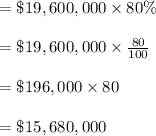
Business, 19.03.2021 18:30 niquermonroeee
Branch Company, a building materials supplier, has $18,400,000 of notes payable due April 12, 2022. At December 31, 2021, Branch signed an agreement with First Bank to borrow up to $18,400,000 to refinance the notes on a long-term basis. The agreement specified that borrowings would not exceed 70% of the value of the collateral that Branch provided. At the date of issue of the December 31, 2021, financial statements, the value of Branch's collateral was $19,600,000. On its December 31, 2021, balance sheet, Branch should classify the notes as follows:
a. $18,400,000 of long-term liabilities.
b. $18,400,000 of current liabilities.
c. $3,680,000 long-term and $14,720,000 current liabilities.
d. $15,680,000 long-term and $2,720,000 current liabilities.

Answers: 1


Other questions on the subject: Business


Business, 22.06.2019 05:00, and7393
Xie company identified the following activities, costs, and activity drivers for 2017. the company manufactures two types of go-karts: deluxe and basic. activity expected costs expected activity handling materials $ 625,000 100,000 parts inspecting product 900,000 1,500 batches processing purchase orders 105,000 700 orders paying suppliers 175,000 500 invoices insuring the factory 300,000 40,000 square feet designing packaging 75,000 2 models required: 1. compute a single plantwide overhead rate, assuming that the company assigns overhead based on 125,000 budgeted direct labor hours. 2. in january 2017, the deluxe model required 2,500 direct labor hours and the basic model required 6,000 direct labor hours. assign overhead costs to each model using the single plantwide overhead rate.
Answers: 3

Business, 22.06.2019 06:40, jesh0975556
After the 2008 recession, the amount of reserves in the us banking system increased. because of federal reserve actions, required reserves increased from $44 billion to $60 billion. however, banks started holding more reserves than required. by january 2009, banks were holding $900 billion in excess reserves. the federal reserve started paying interest on the excess reserves that the banks held. what possible impact will these unused reserves have on the economy?
Answers: 1
You know the right answer?
Branch Company, a building materials supplier, has $18,400,000 of notes payable due April 12, 2022....
Questions in other subjects:

Mathematics, 15.04.2021 07:30



Mathematics, 15.04.2021 07:30

English, 15.04.2021 07:30

Mathematics, 15.04.2021 07:30

Mathematics, 15.04.2021 07:30









